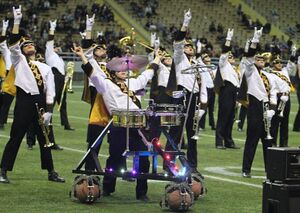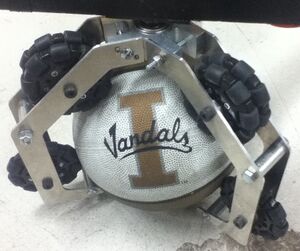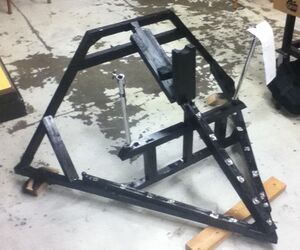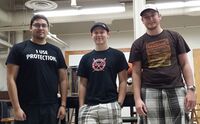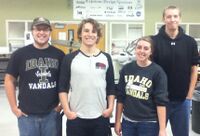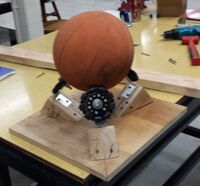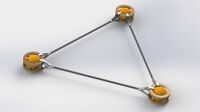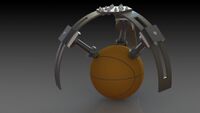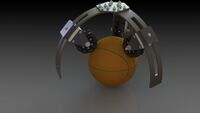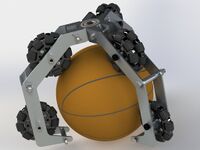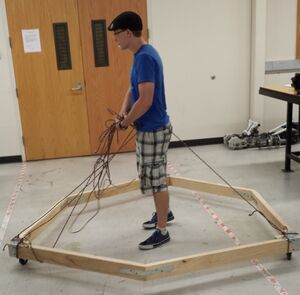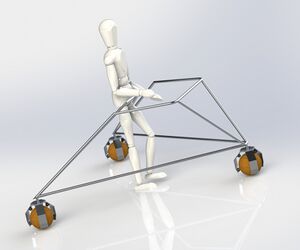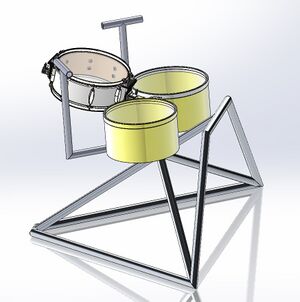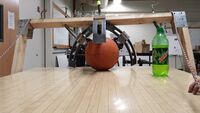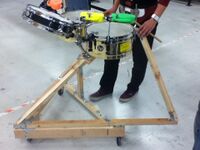Band-Beesten rolling drum set
This is an interdepartmental effort to create a fully mobile drum set for use by the Vandal Marching Band.
| Finale for a halftime performance
(photo courtesy of Meredith Metsker) | |
| Sponsors | |
| Team Name | The Band-Beesten Experience |
| Duration | Summer - Fall 2013 |
| Faculty Advisers |
|
| Mentor |
|
Final Design
| Photo | Overview |
|---|---|
Full Assembly
| |
Omni-Ball Wheel Assembly
| |
Frame
|
Team Members
| Photo | Members |
|---|---|
Pictured from left to right:
| |
Pictured from left to right:
|
Background
The original idea for the project began a few years before the Fall of 2011 by Dr. Edwin Odom, Professor of Mechanical Engineering, and Dr. Daniel Bukvich, Professor of Percussion and Music Theory. The plan was to collaborate between their disciplines and create a finely tuned, expertly engineered drum set that is fit for a full on-field marching band performance.
The Fall of 2011 marked the initial experimentation and design of the Beest by a Capstone Design team in the engineering department. These initial tests provided insight on what worked well and what needed improvement. The final design from this year was never seen outside of the engineering buildings on campus, but the following year's goals were clear and a new design began immediately. For more in depth design details refer to the Team Drum Roll webpage.
The Fall of 2012 marked the first public introduction of the Beest, which has become a yearly project in the Capstone Design process. Dan Mathewson, a University of Idaho graduate student, designed and utilized a robotic, power driven front wheel that responded to the drummers input and included brightly lit led's on the forward facing drums. It successfully astounded the audience and fulfilled the requirement of marching with a wheeled drum set, but it could still be improved. Dan's thesis can be found in the References section.
The goal of the 2013 Band-Beesten Experience team is to recreate the Beest to operate fully under the drummer control without the robotic assistance while making it bigger and better than before.
Design Specifications
- Carry at minimum:
- One 14” diameter, 8” deep, 8lb Timbale
- One 15” diameter, 8” deep, 9lb Timbale
- One 14” diameter, 4” deep, 13lb snare
- One 18” diameter, 4lb cymbal
- One 19” diameter, 7lb roto-tom
- General features:
- Move in all directions on a single plane (forward, backward, side to side, and radially)
- Move freely in those directions at marching speeds up to 2 m/s
- Adjust to a wide range of user heights
- Lightweight, ~100lbs
- Free-standing
- Human powered (No motored assistance)
Project Learning
| Interviewee | Overview |
|---|---|
| Dan Mathewson
Graduate student who worked on 2012 Band Beesten model |
Frame and Omni-Wheel Tips
|
| Denise Bauer
Professor of Mechanical Engineering with an emphasis in Human Factors |
Operational Factors
General Facts
|
Design Development
Wheel Design
- Problems from 2012:
- Needed power assistance to roll omni-wheels
- Basketball lost air occassionally
- Plastic balls on back did not roll well on turf
- Metal casters became dirty and would not spin properly depending on orientation
- Improvements for 2013:
- Find a lower friction alternative setup for omni-wheels and casters
- Allow for high loads on each wheel
- Each wheel must roll smoothly on various surfaces, especially turf
- Basketball testing to prove/disprove it as a viable option
| Design | Description | Pros/Cons |
|---|---|---|
| Visualization Test Platform
A small test platform test was created with thin bent brackets bolted onto angled wood blocks. Three of these were created and oriented so that the wheels would touch a ball at roughly the same angle. The ball was then rotated by hand to see how the orientation functioned. |
Pros:
Cons:
| |
| Initial Wheel Concept
This is a concept render of a possible solution to the ball wheels. This idea uses six ball casters, three on each of the top and bottom rings. Each ring is connected rigidly in a triangular shape with a series of tubes and clamps, while using the weight of the drum set to keep the ball in place. |
Pros:
Cons:
| |
| Friction Testing Concept
These are renders of the platform used to test the friction coefficients of casters and omni-wheels. The apparatus allows for the use of both casters and omni-wheels, and their position can be adjusted to find the optimal settings. The omni-wheels can be rotated in 90o increments to test for the most effective orientation. An electronic fish scale will be used to measure the amount of force needed to pull the apparatus across a table. The test is explained in more detail in the Omni-Wheel/Ball Caster Friction Testing section below. |
Pros:
Cons:
| |
| Final Concept
This is a final render of the omni-ball assembly devised after the tests. It requires three, vertically oriented, double omni-wheels spaced evenly along the upper portion of the ball as well as three single omni-wheels along the under section to provide support. The angle of the top tier of omni-wheels is measured at 50o from the equator of the basketball, while the lower supporting wheels are on the equator. The lower omni-wheels are spaced 1/4 inch from the ball and are only in place as support to prevent the ball from escaping. All of the arms are identical, interchangeable, and easy to manufacture in large groups. The inner hub contains a bearing that will allow the wheel to rotate toward the most natural orientation.
|
Pros:
Cons:
|
Frame Design
- Problems from 2012:
- Raised body made drum arrangement difficult for percussionist
- Each leg delayed movement slightly in all directions
- Not easy to customize instrument type or layout
- Overweight and bulky, not easy to transport
- Not visually appealing or ergonomic
- Improvements for 2013:
- Lower center of gravity of full setup
- Rework drummer input system
- Stiffen wheel attachment for a more immediate response to movement
- Improve possibility of customization
| Condition (right)
Shape (below) |
Strength | Manuf. | Appear. | Combine. | Drum Arrange. | Step Range | Harness Attach. | Total |
|---|---|---|---|---|---|---|---|---|
| 5 | 5 | 3 | 5 | 5 | 3 | 5 | 31 | |
| 3 | 4 | 3 | 2 | 4 | 4 | 4 | 24 | |
| 3 | 2 | 5 | 1 | 3 | 5 | 2 | 21 | |
| 4 | 3 | 5 | 3 | 4 | 4 | 3 | 26 | |
| 4 | 5 | 4 | 5 | 5 | 5 | 5 | 33 |
| Design | Description | Pros/Cons |
|---|---|---|
| Hexagon, Frame Version 1
The Hex-like shaped frame is the top choice from the table above. It was built out of wood and metal brackets, with casters in three corners. It should be noted that it is not a perfect hexagonal shape. The angle at which the casters are connected is 135o, while the others are 105o. These angles were chosen to provide optimum step range with a drummer in the center. The lower picture is a test of an all strap/rope drummer connection at three points on the frame. |
Pros:
Cons:
| |
| Triangle, Version 2
This is a render of a triangular frame design that was conceptualized. The triangular frame shape is the second choice from the above table. The triangle shape should provide more strength than the hexagon. Instead of a beam connecting the two back wheels directly, the beam goes up to a harness connection point. |
Pros:
Cons:
| |
| Tetrahedron, Version 3
This is a second version of the triangular frame design. Similar to version 2 but slightly smaller in volume. The two arms reaching around the drums are "multi-bars" that allow for cymbal attachment or various other accessories, ie. cow bells or wood blocks. The accessories could also be attached directly to the drums along their rims. Manufacturing could be simple, with basic cuts and welds to each part at their respective angles. |
Pros:
Cons:
|
Testing
| Test Photo | Overview | Results |
|---|---|---|
| Fishing Scale Correlation Testing
Objective: We needed an equation that correlated the voltage output of the fishing scale to the force of the pull. Set-up: A fish scale is being used to measure the force required to move the wheel testing apparatus. In conjunction with the scale, there is a DATAQ-155 data acquisition device that can be connected to a computer to record the voltage changes of the pulling force. In order to use this and accurately measure the force for each pull it needs to be calibrated and an equation formulated for the final test. A more detailed explanation can be found in the final report: |
The data was compiled in Excel and the final correlations were calculated.
They can be found in the link below: | |
|
Error creating thumbnail: convert: Corrupt JPEG data: 158 extraneous bytes before marker 0xeb `/var/www/images/mindworks/0/01/FrictionTest2.jpg' @ warning/jpeg.c/JPEGWarningHandler/386. convert: Corrupt JPEG data: found marker 0xeb instead of RST0 `/var/www/images/mindworks/0/01/FrictionTest2.jpg' @ warning/jpeg.c/JPEGWarningHandler/386. convert: Corrupt JPEG data: premature end of data segment `/var/www/images/mindworks/0/01/FrictionTest2.jpg' @ warning/jpeg.c/JPEGWarningHandler/386. convert: Corrupt JPEG data: found marker 0xeb instead of RST1 `/var/www/images/mindworks/0/01/FrictionTest2.jpg' @ warning/jpeg.c/JPEGWarningHandler/386. convert: Corrupt JPEG data: found marker 0xeb instead of RST2 `/var/www/images/mindworks/0/01/FrictionTest2.jpg' @ warning/jpeg.c/JPEGWarningHandler/386. convert: Corrupt JPEG data: found marker 0xeb instead of RST3 `/var/www/images/mindworks/0/01/FrictionTest2.jpg' @ warning/jpeg.c/JPEGWarningHandler/386. convert: Corrupt JPEG data: found marker 0xeb instead of RST4 `/var/www/images/mindworks/0/01/FrictionTest2.jpg' @ warning/jpeg.c/JPEGWarningHandler/386. convert: Corrupt JPEG data: found marker 0xeb instead of RST5 `/var/www/images/mindworks/0/01/FrictionTest2.jpg' @ warning/jpeg.c/JPEGWarningHandler/386. convert: Corrupt JPEG data: found marker 0xeb instead of RST6 `/var/www/images/mindworks/0/01/FrictionTest2.jpg' @ warning/jpeg.c/JPEGWarningHandler/386. convert: Corrupt JPEG data: found marker 0xeb instead of RST7 `/var/www/images/mindworks/0/01/FrictionTest2.jpg' @ warning/jpeg.c/JPEGWarningHandler/386. convert: Corrupt JPEG data: found marker 0xeb instead of RST0 `/var/www/images/mindworks/0/01/FrictionTest2.jpg' @ warning/jpeg.c/JPEGWarningHandler/386. convert: Corrupt JPEG data: found marker 0xeb instead of RST1 `/var/www/images/mindworks/0/01/FrictionTest2.jpg' @ warning/jpeg.c/JPEGWarningHandler/386. convert: Corrupt JPEG data: found marker 0xeb instead of RST2 `/var/www/images/mindworks/0/01/FrictionTest2.jpg' @ warning/jpeg.c/JPEGWarningHandler/386. convert: Corrupt JPEG data: found marker 0xeb instead of RST3 `/var/www/images/mindworks/0/01/FrictionTest2.jpg' @ warning/jpeg.c/JPEGWarningHandler/386. convert: Corrupt JPEG data: found marker 0xeb instead of RST4 `/var/www/images/mindworks/0/01/FrictionTest2.jpg' @ warning/jpeg.c/JPEGWarningHandler/386. convert: Corrupt JPEG data: found marker 0xeb instead of RST5 `/var/www/images/mindworks/0/01/FrictionTest2.jpg' @ warning/jpeg.c/JPEGWarningHandler/386. convert: Corrupt JPEG data: found marker 0xeb instead of RST6 `/var/www/images/mindworks/0/01/FrictionTest2.jpg' @ warning/jpeg.c/JPEGWarningHandler/386. convert: Corrupt JPEG data: found marker 0xeb instead of RST7 `/var/www/images/mindworks/0/01/FrictionTest2.jpg' @ warning/jpeg.c/JPEGWarningHandler/386. convert: Corrupt JPEG data: found marker 0xeb instead of RST0 `/var/www/images/mindworks/0/01/FrictionTest2.jpg' @ warning/jpeg.c/JPEGWarningHandler/386. convert: Corrupt JPEG data: found marker 0xeb instead of RST1 `/var/www/images/mindworks/0/01/FrictionTest2.jpg' @ warning/jpeg.c/JPEGWarningHandler/386. convert: Corrupt JPEG data: found marker 0xeb instead of RST2 `/var/www/images/mindworks/0/01/FrictionTest2.jpg' @ warning/jpeg.c/JPEGWarningHandler/386. convert: Corrupt JPEG data: found marker 0xeb instead of RST3 `/var/www/images/mindworks/0/01/FrictionTest2.jpg' @ warning/jpeg.c/JPEGWarningHandler/386. convert: Corrupt JPEG data: found marker 0xeb instead of RST4 `/var/www/images/mindworks/0/01/FrictionTest2.jpg' @ warning/jpeg.c/JPEGWarningHandler/386. convert: Corrupt JPEG data: found marker 0xeb instead of RST5 `/var/www/images/mindworks/0/01/FrictionTest2.jpg' @ warning/jpeg.c/JPEGWarningHandler/386. convert: Corrupt JPEG data: found marker 0xeb instead of RST6 `/var/www/images/mindworks/0/01/FrictionTest2.jpg' @ warning/jpeg.c/JPEGWarningHandler/386. convert: Corrupt JPEG data: found marker 0xeb instead of RST7 `/var/www/images/mindworks/0/01/FrictionTest2.jpg' @ warning/jpeg.c/JPEGWarningHandler/386. convert: Corrupt JPEG data: found marker 0xeb instead of RST0 `/var/www/images/mindworks/0/01/FrictionTest2.jpg' @ warning/jpeg.c/JPEGWarningHandler/386. convert: Corrupt JPEG data: found marker 0xeb instead of RST1 `/var/www/images/mindworks/0/01/FrictionTest2.jpg' @ warning/jpeg.c/JPEGWarningHandler/386. convert: Corrupt JPEG data: found marker 0xeb instead of RST2 `/var/www/images/mindworks/0/01/FrictionTest2.jpg' @ warning/jpeg.c/JPEGWarningHandler/386. convert: Corrupt JPEG data: found marker 0xeb instead of RST3 `/var/www/images/mindworks/0/01/FrictionTest2.jpg' @ warning/jpeg.c/JPEGWarningHandler/386. convert: Corrupt JPEG data: found marker 0xeb instead of RST4 `/var/www/images/mindworks/0/01/FrictionTest2.jpg' @ warning/jpeg.c/JPEGWarningHandler/386. convert: Corrupt JPEG data: found marker 0xeb instead of RST5 `/var/www/images/mindworks/0/01/FrictionTest2.jpg' @ warning/jpeg.c/JPEGWarningHandler/386. convert: Corrupt JPEG data: found marker 0xeb instead of RST6 `/var/www/images/mindworks/0/01/FrictionTest2.jpg' @ warning/jpeg.c/JPEGWarningHandler/386. convert: Corrupt JPEG data: found marker 0xeb instead of RST7 `/var/www/images/mindworks/0/01/FrictionTest2.jpg' @ warning/jpeg.c/JPEGWarningHandler/386. convert: Corrupt JPEG data: found marker 0xeb instead of RST0 `/var/www/images/mindworks/0/01/FrictionTest2.jpg' @ warning/jpeg.c/JPEGWarningHandler/386. convert: Corrupt JPEG data: found marker 0xeb instead of RST1 `/var/www/images/mindworks/0/01/FrictionTest2.jpg' @ warning/jpeg.c/JPEGWarningHandler/386. convert: Corrupt JPEG data: found marker 0xeb instead of RST2 `/var/www/images/mindworks/0/01/FrictionTest2.jpg' @ warning/jpeg.c/JPEGWarningHandler/386. convert: Corrupt JPEG data: found marker 0xeb instead of RST3 `/var/www/images/mindworks/0/01/FrictionTest2.jpg' @ warning/jpeg.c/JPEGWarningHandler/386. convert: Corrupt JPEG data: found marker 0xeb instead of RST4 `/var/www/images/mindworks/0/01/FrictionTest2.jpg' @ warning/jpeg.c/JPEGWarningHandler/386. convert: Corrupt JPEG data: found marker 0xeb instead of RST5 `/var/www/images/mindworks/0/01/FrictionTest2.jpg' @ warning/jpeg.c/JPEGWarningHandler/386. convert: Corrupt JPEG data: found marker 0xeb instead of RST6 `/var/www/images/mindworks/0/01/FrictionTest2.jpg' @ warning/jpeg.c/JPEGWarningHandler/386. convert: Corrupt JPEG data: found marker 0xeb instead of RST7 `/var/www/images/mindworks/0/01/FrictionTest2.jpg' @ warning/jpeg.c/JPEGWarningHandler/386. convert: Corrupt JPEG data: found marker 0xeb instead of RST0 `/var/www/images/mindworks/0/01/FrictionTest2.jpg' @ warning/jpeg.c/JPEGWarningHandler/386. convert: Corrupt JPEG data: found marker 0xeb instead of RST1 `/var/www/images/mindworks/0/01/FrictionTest2.jpg' @ warning/jpeg.c/JPEGWarningHandler/386. convert: Corrupt JPEG data: found marker 0xeb instead of RST2 `/var/www/images/mindworks/0/01/FrictionTest2.jpg' @ warning/jpeg.c/JPEGWarningHandler/386. convert: Corrupt JPEG data: found marker 0xeb instead of RST3 `/var/www/images/mindworks/0/01/FrictionTest2.jpg' @ warning/jpeg.c/JPEGWarningHandler/386. convert: Corrupt JPEG data: found marker 0xeb instead of RST4 `/var/www/images/mindworks/0/01/FrictionTest2.jpg' @ warning/jpeg.c/JPEGWarningHandler/386. convert: Corrupt JPEG data: found marker 0xeb instead of RST5 `/var/www/images/mindworks/0/01/FrictionTest2.jpg' @ warning/jpeg.c/JPEGWarningHandler/386. convert: Corrupt JPEG data: found marker 0xeb instead of RST6 `/var/www/images/mindworks/0/01/FrictionTest2.jpg' @ warning/jpeg.c/JPEGWarningHandler/386. convert: Corrupt JPEG data: found marker 0xeb instead of RST7 `/var/www/images/mindworks/0/01/FrictionTest2.jpg' @ warning/jpeg.c/JPEGWarningHandler/386. convert: Corrupt JPEG data: found marker 0xeb instead of RST0 `/var/www/images/mindworks/0/01/FrictionTest2.jpg' @ warning/jpeg.c/JPEGWarningHandler/386. convert: Corrupt JPEG data: found marker 0xeb instead of RST1 `/var/www/images/mindworks/0/01/FrictionTest2.jpg' @ warning/jpeg.c/JPEGWarningHandler/386. convert: Corrupt JPEG data: found marker 0xeb instead of RST2 `/var/www/images/mindworks/0/01/FrictionTest2.jpg' @ warning/jpeg.c/JPEGWarningHandler/386. convert: Corrupt JPEG data: found marker 0xeb instead of RST3 `/var/www/images/mindworks/0/01/FrictionTest2.jpg' @ warning/jpeg.c/JPEGWarningHandler/386. convert: Corrupt JPEG data: found marker 0xeb instead of RST4 `/var/www/images/mindworks/0/01/FrictionTest2.jpg' @ warning/jpeg.c/JPEGWarningHandler/386. convert: Corrupt JPEG data: found marker 0xeb instead of RST5 `/var/www/images/mindworks/0/01/FrictionTest2.jpg' @ warning/jpeg.c/JPEGWarningHandler/386. convert: Corrupt JPEG data: found marker 0xeb instead of RST6 `/var/www/images/mindworks/0/01/FrictionTest2.jpg' @ warning/jpeg.c/JPEGWarningHandler/386. convert: Corrupt JPEG data: found marker 0xeb instead of RST7 `/var/www/images/mindworks/0/01/FrictionTest2.jpg' @ warning/jpeg.c/JPEGWarningHandler/386. convert: Corrupt JPEG data: found marker 0xeb instead of RST0 `/var/www/images/mindworks/0/01/FrictionTest2.jpg' @ warning/jpeg.c/JPEGWarningHandler/386. convert: Corrupt JPEG data: found marker 0xeb instead of RST1 `/var/www/images/mindworks/0/01/FrictionTest2.jpg' @ warning/jpeg.c/JPEGWarningHandler/386. convert: Corrupt JPEG data: found marker 0xeb instead of RST2 `/var/www/images/mindworks/0/01/FrictionTest2.jpg' @ warning/jpeg.c/JPEGWarningHandler/386. convert: Corrupt JPEG data: found marker 0xeb instead of RST3 `/var/www/images/mindworks/0/01/FrictionTest2.jpg' @ warning/jpeg.c/JPEGWarningHandler/386. convert: Corrupt JPEG data: found marker 0xeb instead of RST4 `/var/www/images/mindworks/0/01/FrictionTest2.jpg' @ warning/jpeg.c/JPEGWarningHandler/386. convert: Corrupt JPEG data: found marker 0xeb instead of RST5 `/var/www/images/mindworks/0/01/FrictionTest2.jpg' @ warning/jpeg.c/JPEGWarningHandler/386. convert: too many exceptions (exception processing is suspended) @ error/exception.c/ThrowException/974. Error code: 1 |
Omni-Wheel/Ball Caster Friction Testing
Objective: We needed to find the optimum wheel type, orientation, and angle placement to produce a ball wheel with the lowest friction possible. Set-up: The apparatus is pulled with the fishing scale to measure the force needed to move the wheel from a resting position. Three types of wheels are being tested, single omni-wheels, paired omni-wheels, and ball casters. The types will be tested using angles ranging from 40o up to 55o, and the omni-wheels will be oriented either vertically or horizontally. Once the forces are recorded and the apparatus is weighed, the friction can be calculated for each variation. For the full test explanation, see the final report: |
The test revealed that the friction reduces as the angle rises.
The best orientation for a final product is with the paired omni-wheels in the horizontal orientation at 50o from the equator of the basketball. This orientation is deemed best as long as there are supporting wheels below the equator to prevent the ball from rolling off of the wheel base. See more detailed results below: |
| Tetrahedron Frame Testing
Objective: We needed to create a physical mock-up of the frame to find flaws and work on improvements before creating the final design. Set-up: This frame was a wood mock-up of version 3 seen in the Frame Design section above with slight modification for visualization purposes. It was built with wood donated and cut by the College of Natural Resources, and was pieced together using various screws and brackets. |
The mock-up worked well and provided a chance to modify it quickly and reinforce where necessary. Due to time constraints, this frame became part of the final design. It could use some further redesigning and testing to be more complete and easier to recreate but worked well for the purposes of this project. |
Document Archive
References
